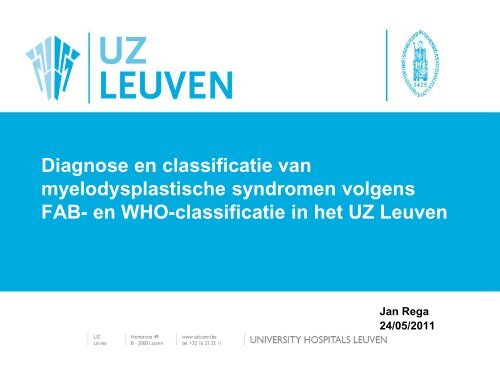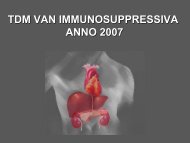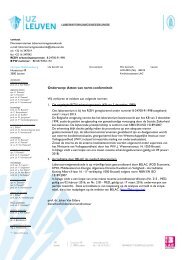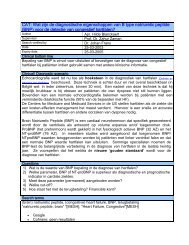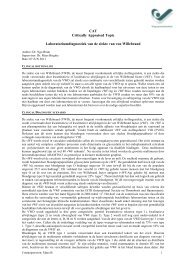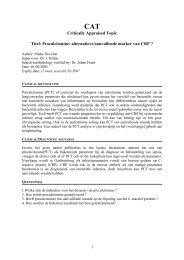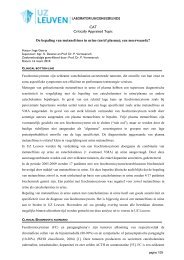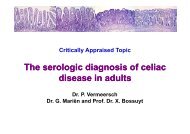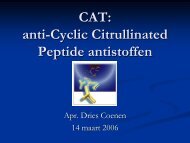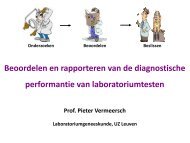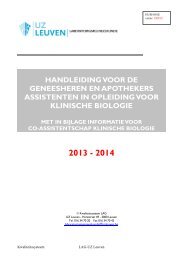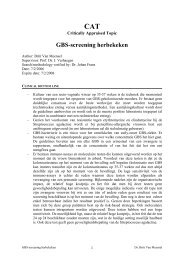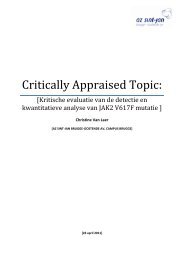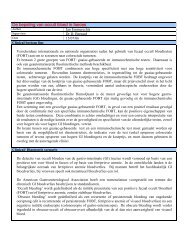Diagnose en classificatie van myelodysplastische ... - UZ Leuven
Diagnose en classificatie van myelodysplastische ... - UZ Leuven
Diagnose en classificatie van myelodysplastische ... - UZ Leuven
- No tags were found...
Create successful ePaper yourself
Turn your PDF publications into a flip-book with our unique Google optimized e-Paper software.
1.Definitie• Heterog<strong>en</strong>e groep <strong>van</strong> clonale haematopoïetischestamcelziekt<strong>en</strong>• Ineffectieve haematopoiese vaak gepaard gaandmet toeg<strong>en</strong>om<strong>en</strong> apoptose• Perifere cytop<strong>en</strong>ie(ën) (RBC>BLP>WBC igv.unicytop<strong>en</strong>ie)• Dysplasie in 1 of (vaak) meerderehaematopoïetische cellijn<strong>en</strong> in bloed <strong>en</strong>/of be<strong>en</strong>merg• Verhoogd risico op AML (‘preleukemie’) (+/- 30%)
Inhoud1. Definitie2. Epidemiologie <strong>en</strong> etiologie3. Kliniek4. Diagnostiek5. Classificatie6. Retrospectieve analyse7. Besluit8. To do’s
2. Epidemiologie <strong>en</strong> etiologie• Vooral oudere leeftijd:– Mediane leeftijd 70j– Incid<strong>en</strong>tie 3-5/100.000/jaar →>20/100.000/jaar(>70j)– Man > vrouw• Etiologie:– De novo of primair (b<strong>en</strong>ze<strong>en</strong>, rokers,pesticid<strong>en</strong>,…)– Secundair (chemotherapie, radiotherapie)
Inhoud1. Definitie2. Epidemiologie <strong>en</strong> etiologie3. Kliniek4. Diagnostiek5. Classificatie6. Retrospectieve analyse7. Besluit8. To do’s
3. Kliniek• Vaak toevallige vondst• Symptom<strong>en</strong> bij uitgesprok<strong>en</strong> cytop<strong>en</strong>ie(ën):– anemie (kortademigheid, vermoeidheid,…)– trombop<strong>en</strong>ie (bloeding<strong>en</strong>,…)– neutrop<strong>en</strong>ie (recurr<strong>en</strong>te infecties, orale ulcera,…)– hepato-spl<strong>en</strong>omegalie weinig frequ<strong>en</strong>t– …• Transfusi<strong>en</strong>ood – ijzerstapeling• Multi-orgaanfal<strong>en</strong>• Auto-immuunf<strong>en</strong>om<strong>en</strong><strong>en</strong>: gewrichtslijd<strong>en</strong>, cutanevasculitis, Sweet syndroom,…• Prognose <strong>en</strong> overleving ~ type MDS, IPSS, WPSS,..
Inhoud1. Definitie2. Epidemiologie <strong>en</strong> etiologie3. Kliniek4. Diagnostiek5. Classificatie6. Retrospectieve analyse7. Besluit8. To do’s
4.Diagnostiek• Kliniek• PB• BM• Botbiopt:• Cytog<strong>en</strong>etica• (Moleculaire g<strong>en</strong>etica, IF,…)
NCCN-richtlijn ,2010
Richtlijn ELN,2009
Cytologie PB/BM• Persister<strong>en</strong>de perifere cytop<strong>en</strong>ie(ën)• Dysplasie: ≥10% dysplastische cell<strong>en</strong>in één of meerdere cellijn<strong>en</strong>:– erytroïde reeks (dysertropoïese)– myeloïde reeks (dysgranulopoïese)– megakaryocytaire reeks(dysmegakaryopoïese)
Dysplastische afwijking<strong>en</strong>DyserytropoïeseDysgranulopoïeseDysmegakaryopoïesePerifeerMacrocytoseAniso-/poikilocytoseDimorfBasofiele stippelingFragm<strong>en</strong>tocyt<strong>en</strong>Afwijk<strong>en</strong>de normoblast<strong>en</strong>Hypo-/hypergranulatieHyposegm<strong>en</strong>tatie (pseudo-Pelger, ringvorm<strong>en</strong>),hypersegm<strong>en</strong>tatie, Döhlebodies, clumpingchromatineMegatrombocyt<strong>en</strong>, hypo-/hypergranulatieC<strong>en</strong>traalMegaloblastoïdKernafwijking<strong>en</strong>Cytoplasma-afwijking<strong>en</strong>(basofilie, Howell-jollylichaampjes, “ghostedcytoplasma),ringsideroblast<strong>en</strong>Hypo-hypergranulatieAtypische korreling(vacuolisatie, basofieleeosinofielekorreling),myelocyt<strong>en</strong> & stav<strong>en</strong> metmonocytaire k<strong>en</strong>merk<strong>en</strong>Micro-megakaryocyt<strong>en</strong>Grote mononucleairemegakaryocyt<strong>en</strong>, grotemegakaryocyt<strong>en</strong>…
Andere oorzak<strong>en</strong> dysplasie• Vitamine B12- <strong>en</strong> foliumzuurdeficiëntie• Blootstelling zware metal<strong>en</strong>• Direct voorafgaandelijke chemotherapie• Onstekingsreacties (oa. HIV) <strong>en</strong> kanker• Chronische leverziekte <strong>en</strong> alcohol
Histologie
Cytog<strong>en</strong>etica
Moleculaire g<strong>en</strong>etica• Mutaties in individuele g<strong>en</strong><strong>en</strong>geïd<strong>en</strong>tificeerd die gelinked zijn met oa.MDS (FLT3, RAS, MLL, RAS,…)• Meer inzicht nodig in moleculairepathog<strong>en</strong>ese MDS• Contributie in diagnostiek MDS thansonvoldo<strong>en</strong>de uitgeklaard
Minimaal diagnostische criteria <strong>en</strong>ICUS• NCCN• IWG• ELN– > 2007; val<strong>en</strong>t et al.: cons<strong>en</strong>sus rapportMDC• 2005, Mufti et al.: ‘ICUS’
Inhoud1. Definitie2. Epidemiologie <strong>en</strong> etiologie3. Kliniek4. Diagnostiek5. Classificatie6. Retrospectieve analyse7. Besluit8. To do’s
5.ClassificatieDoel:• Prognose• Therapeutische beslissing<strong>en</strong>Voorwaard<strong>en</strong>:• Reproduceerbaar• Biologisch rele<strong>van</strong>t ~ prognose• E<strong>en</strong>voudig• Algeme<strong>en</strong> aanvaard <strong>en</strong> gebruikt• Weinig verandering<strong>en</strong> in de tijd
Ste<strong>en</strong>sma, D. P. Hematology 2009;2009:645-655
Fr<strong>en</strong>ch-American-British (FAB)-<strong>classificatie</strong>• 1982• Gebaseerd op:– % blast<strong>en</strong> in PB/BM– ringsideroblast<strong>en</strong>– # monocyt<strong>en</strong> in PB– Auerstav<strong>en</strong>
PBBMRefractaire anemie (RA) BL < 1% BL < 5%RA met ringsideroblast<strong>en</strong>(RARS)BL < 1% BL < 5%Ringsideroblast<strong>en</strong>> 15% <strong>van</strong> de erytroblast<strong>en</strong>RA met excess <strong>van</strong> blast<strong>en</strong>(RAEB)BL < 5% BL 5 – 20%RAEB in transformatie(RAEB-t)BL > 5%BL 20 – 30% ofaanwezigheid <strong>van</strong>Auerstav<strong>en</strong>Chronischemyelomonocytaire leukemie(CMML)Elke bov<strong>en</strong>staande met> 10*9/L monocyt<strong>en</strong>Elke bov<strong>en</strong>staande metpromonocyt<strong>en</strong>
Kritiek op FAB• Heterog<strong>en</strong>e subgroep<strong>en</strong>– variabel aantal cellijn<strong>en</strong>– variabele outcome– variabele cytog<strong>en</strong>etica (oa. 5q- syndroom)– CMML eerder myeloproliferatieveaando<strong>en</strong>ing? WHO 2001
WHO 2001 vs FAB• 20% blast<strong>en</strong> ipv. 30% blast<strong>en</strong> voor AL(zeer ongunstige prognose <strong>en</strong> 50 à 60%evolutie naar AML bij 20-30% blast<strong>en</strong>)• sommige patiënt<strong>en</strong> RAEB-t zonderk<strong>en</strong>merk<strong>en</strong> <strong>van</strong> dysplasie• # aangetaste cellijn<strong>en</strong> invloed op deprognose
WHO 2001RA(RS)(FAB)RA(RS) (WHO): <strong>en</strong>kel RR aangetast (>15% RS)Refractaire cytop<strong>en</strong>ie met multilijn<strong>en</strong> dysplasie (RCMD)(RS)MDS niet classifieerbaar (MDS-U): <strong>en</strong>kel MR of MK reeks aangetastMDS geassocieerd met geïsoleerde del(5q)
WHO 2001RAEBRAEB-1:5-9% blast<strong>en</strong> in BMUni-of multilineairedysplasieRAEB-2:10-19% blast<strong>en</strong> in BM evt.Auerstav<strong>en</strong>Uni-of multilineairedysplasie
WHO typeMedian survivalCumulative risk of AMLevolution after 2 years(%)RA 67 4RARS 68 2RCMD 33 12RSCMD 31 125q-Syndrome 96 9RAEBI 18 25RAEBII 12 50
WHO 2001MAAR:• Voorwaarde: e<strong>en</strong>voudig?• Unilineaire (niet-erytroïde) dysplasie?• Cytop<strong>en</strong>ie met cytog<strong>en</strong>etischeafwijking<strong>en</strong> zonder dysplasie?• Pediatrische MDS, MDS met fibrose,hypoplastische MDS?
WHO 2008 vs WHO 2001• RCUD: RA + RT + RN• Childhood MDS (inclusief RCC)• RCMD <strong>en</strong> RCMD-RS: 1 categorie• t-MDS: ge<strong>en</strong> onderscheid tuss<strong>en</strong>topomerase-inhibitor<strong>en</strong> <strong>en</strong> alkyler<strong>en</strong>deag<strong>en</strong>tia• MDS-U: verfijnd
MDS-RARefractory anemia without ringed sideroblasts
MDS-RARSRefractory anemia with ringed sideroblasts
MDS-RCMDRefractory cytop<strong>en</strong>ia with multi-lineage dysplasia
MDS-RAEBRefractory anemia with excess blastsRAEB I (5-9% blasts) – RAEB II (10-19% blasts)
Blast<strong>en</strong>exces
MDS associated with isolated del (5q)5q- syndrome
Prognostische factor<strong>en</strong> in MDSClinical parametersAgePrevious exposure to radiation of chemotherapyLaboratory findingsNumber and degree of cytop<strong>en</strong>ias in bloodLDH activityThymidinkinase activityß2-microglobulinPres<strong>en</strong>ce of peripheral blastsBone marrow morphologyBlast cell countWHO typeDegree of dysplasiaNumber of dysplastic cell linesMyelofibrosisAbnormal localization of immature precursors(ALIP)Cytog<strong>en</strong>etic findingsNumerical aberrationsStructural aberrationsKaryotypic evolutionClonal statusHypo- of hyperploidityMolecular findingsP53 mutationsImmunoph<strong>en</strong>otypingCD13, CD33, CD34 expressionLymphoid markersP170 glycoprotein expressionBone marrow culturingAbortive myeloid cluster formationPres<strong>en</strong>ce of clonog<strong>en</strong>ic leukaemic cells
International Prognostic Scoring(IPSS) System (IPSS)
Inhoud1. Definitie2. Epidemiologie <strong>en</strong> etiologie3. Kliniek4. Diagnostiek5. Classificatie6. Retrospectieve analyse7. Besluit8. To do’s
6.Retrospectieve analysePatiënt<strong>en</strong> <strong>en</strong> method<strong>en</strong>:• 2006-2009: alle patiënt<strong>en</strong> met vermoed<strong>en</strong> <strong>van</strong>MDS (n=214), nazicht KWS, cytologie, APO,KT• Nieuwe diagnoses MDS weerhoud<strong>en</strong> (n=98)• Cytologisch onderzoek: 100 cell<strong>en</strong> PB/300 BM,verslag volg<strong>en</strong>s FAB <strong>en</strong> WHO 2001 of 2008• Histologisch botbooronderzoek met kleuring<strong>en</strong>• Cytog<strong>en</strong>etica: minimaal 20 metafas<strong>en</strong>, somsaangevuld met FISH-onderzoek
A) Verdeling volg<strong>en</strong>s FAB-WHO2001/2008• 24 RA (25%)• 21 RARS (22%)• 35 RAEB (36%)• 7 RAEBt (7%)• 9 CMML (9%)
A) Verdeling volg<strong>en</strong>s FAB-WHO2001/20085 RA(5%)15 RCMD (17%)2 Del(5q) (2%)2 t-MDS (2%)7 RARS (7%)12 RCMD-RS (13%)2 MDS/MPD-U-RARS (2%)16 RAEB-1 (17%)21 RAEB-2 (22%)4 AML (4%)6 CMML-1 (6%)3 CMML-2 (3%)
A) Verdeling volg<strong>en</strong>s FAB-WHO2001/2008• 5 RA (5%): ongewijzigd ivg. met WHO 2001• 27 RCMD (30%): RCMD <strong>en</strong> RCMD-RS• 2 Del(5q) (2%): ongewijzigd ivg. met WHO 2001• 2 t-MDS (2%): ongewijzigd ivg. met WHO 2001• 7 RARS (7%): ongewijzigd ivg. met WHO 2001• 2 MDS/MPN-U-RARS (2%): ongewijzigd ivg. met WHO2001• 16 RAEB-1 (17%): ongewijzigd ivg. met WHO 2001• 21 RAEB-2 (22%): ongewijzigd ivg. met WHO 2001• 4 AML (4%): ongewijzigd ivg. met WHO 2001• 6 CMML-1 (6%): ongewijzigd ivg. met WHO 2001• 3 CMML-2 (3%): ongewijzigd ivg. met WHO 2001
FAB WHO 2001 WHO 2008152RCMD15(17)RA24(25)Del(5q)2(2)RA5(5)t-MDS2(2)RA5(5)RCMD27(30)Del(5q)2(2)t-MDS2(2)RCMD-RS12(13)RARS21(22)RARS7(7)RARS7(7)MDS/MYP-U-RS2(2)MDS/MYP-U-RS2(2)15322152257121227212
FAB WHO 2001 WHO 2008AMLMDS/ MPDRAEB116(17)RAEB221(22)CMML23(3)RAEB35(36)AML4(4)CMML16(6)CMML16(6)CMML23(3)RAEB116(17)RAEB221(22)RAEBt7(7)CMML9(9)AML4(4)t-MDS2(2)t-MDS2(2)21618346363421162
B) Aanvraagpatroon• Frequ<strong>en</strong>tie histologisch onderzoek BMniet aangevraagd?– 57 <strong>van</strong> de 214 gevall<strong>en</strong> (27%)• Frequ<strong>en</strong>tie cytog<strong>en</strong>etisch onderzoek BMniet aangevraagd?– 25 <strong>van</strong> de 214 gevall<strong>en</strong> (12%)• Frequ<strong>en</strong>tie histologisch <strong>en</strong> cytog<strong>en</strong>etischonderzoek BM niet aangevraagd?– 13 <strong>van</strong> de 214 gevall<strong>en</strong> (6%)
C) Diagnostische aspect<strong>en</strong>• ‘S<strong>en</strong>sitiviteit’ <strong>en</strong> ‘specificiteit’cytologisch <strong>en</strong> histologisch be<strong>en</strong>mergonderzoek?S<strong>en</strong>sitiviteitSpecificiteitCytologie 90% 92%Histologie 74% 92%
Concordantie• Gevall<strong>en</strong> <strong>van</strong> MDS waar<strong>van</strong>cytologische, histologische <strong>en</strong>cytog<strong>en</strong>etische resultat<strong>en</strong> beschikbaar(n=79)• Resultat<strong>en</strong> gecodeerd naargelangwaarschijnlijkheid voor diagnose MDS:0,1,2,3: ge<strong>en</strong> MDS/DD/waarschijnlijkMDS/zeer waarschijnlijk MDS-> vere<strong>en</strong>voudigd: ge<strong>en</strong> MDS/DD: ‘-’ <strong>en</strong>waarschijnlijk MDS/zeer waarschijnlijk MDS:‘+’
Concordantie• Cytog<strong>en</strong>etica: aanwezigheid <strong>van</strong>cytog<strong>en</strong>etische afwijking<strong>en</strong> gecodeerdals 1, 2,3 naargelang aard afwijking ofvere<strong>en</strong>voudigd als ‘+’• KWS: weinig waarschijnlijk MDS/DD:0,vermoed<strong>en</strong>, zeer waarschijnlijk,MDS:1,2,3 of vere<strong>en</strong>voudigd 0,1: ‘-’,2,3,4: ‘+’
CytologieCytologie (vere<strong>en</strong>voudigd)0: weinig waarschijnlijk/ge<strong>en</strong> MDS -1: DD -2: vermoed<strong>en</strong> +3: MDS zeer waarschijnlijk +Histologie BMHistologie BM(vere<strong>en</strong>voudigd)0: weinig waarschijnlijk/ge<strong>en</strong> MDS -1: DD -2: vermoed<strong>en</strong>/andere hematologische maligniteit +3: MDS zeer waarschijnlijk +Cytog<strong>en</strong>etica0: normaal KT1: lijst WHO: alle<strong>en</strong> 8, -Y, del (20q) of andere of MOL+ of FISH +2: lijst WHO+ (exclusief 3 afwijking<strong>en</strong> zie 2)3: Complexe/-7Cytog<strong>en</strong>etica(vere<strong>en</strong>voudigd)-+++KWS0: weinig waarschijnlijk/ge<strong>en</strong> MDS1: DD2: vermoed<strong>en</strong>3: MDS zeer waarschijnlijkKWS (vere<strong>en</strong>voudigd)--++4: MDS +
Concordantie bij aanwezigheid MDS
Concordantie bij afwezigheid MDS
Frequ<strong>en</strong>tie voorkom<strong>en</strong> cytog<strong>en</strong>etischeafwijking<strong>en</strong>Cytog<strong>en</strong>etische-afwijking Aantal % Totaal (n=47)C 21 43-Y 7 15+8 4 9del(5q) 4 9-7 3 6del(20q) 2 4-7, +14 1 2+8, +19 1 2del(11q) 1 2Del (5q), del (20q) 1 2del(20q)v 1 2del(1p) 1 2
Frequ<strong>en</strong>tie cytog<strong>en</strong>etische afwijking<strong>en</strong>per WHO (2008)-categorieWHOcategorie-7, +14+8 +8,+19Cytog<strong>en</strong>etischeafwijkingC del 11q Del5q/20qdel(20q)v del5q -Y Eindtotaal5Q- 2 2RAEB1 2 2 3 1 1 1 10RAEB2 1 10 1 1 13RARS 1 1 1 1 4RCMD 1 4 1 1 2 9t-MDS 2 2Eindtotaal 3 1 3 1 20 1 1 1 4 5 40
Inhoud1. Definitie2. Epidemiologie <strong>en</strong> etiologie3. Kliniek4. Diagnostiek5. Classificatie6. Retrospectieve analyse7. Besluit8. To do’s
7.Besluit(1)• Moeilijk diagnose gezi<strong>en</strong> ook discordanties• Verdeling MDS gevall<strong>en</strong> volg<strong>en</strong>s FAB <strong>en</strong> WHO2001/2008 ~ Europese studies• MDS-U, RT/RN niet aangetroff<strong>en</strong>• Overe<strong>en</strong>stemming tuss<strong>en</strong> ondersteun<strong>en</strong>dresultaat cytologie, histologie <strong>en</strong> cytog<strong>en</strong>eticain circa 1/3 bij MDS-gevall<strong>en</strong>• 2/3 gevall<strong>en</strong> cytologie <strong>en</strong> histologie beideondersteun<strong>en</strong>d voor diagnose bij MDSgevall<strong>en</strong>
7.Besluit(2)• Cytog<strong>en</strong>etische afwijking<strong>en</strong> in circa50% <strong>van</strong> de gevall<strong>en</strong>• <strong>Diagnose</strong> soms gesteld <strong>en</strong>kel obv.aanwezigheid cytog<strong>en</strong>etische afwijking• Verbetering mogelijk <strong>van</strong> klinischezorgpad
Inhoud1. Definitie2. Epidemiologie <strong>en</strong> etiologie3. Kliniek4. Diagnostiek5. Classificatie6. Retrospectieve analyse7. Besluit8. To do’s
8.To do’s• Cytologisch onderzoek: meersystematische <strong>classificatie</strong> volg<strong>en</strong>s(FAB), WHO 2008• Nood aan systematische codering <strong>en</strong>registratie <strong>van</strong> hematologischemaligniteit<strong>en</strong> (kankerregistratie, studies,publicaties)• Nood aan multidisciplinair overleg.Werkvoorstel geformuleerd,implem<strong>en</strong>tatie lop<strong>en</strong>de.


